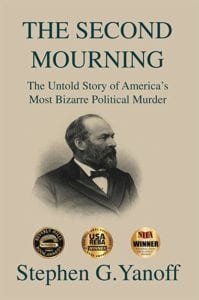
Finalist of the 2015 Shelf Unbound Competition for Best Independently Published Book
The Second Mourning examines the remarkable life of James A. Garfield, the 20th President of the United States. In so doing, it also uncovers the untold story of his assassin, Charles Guiteau, the lunatic who committed one of the most bizarre political murders in American history. The story, which reads like fiction, is set in the late 1800s, a time where fierce battles for power unfold against a backdrop of intrigue, treachery, and violence —SGY
Shelf Unbound: What interested you in writing about President Garfield’s assassination?
Stephen G. Yanoff: As a student of history, I was immediately interested in the remarkable life of James A. Garfield, and I had a hunch that there was a fascinating untold story behind his assassination. As it turned out, there were two fascinating stories. One dealt with President Garfield and the other with his assassin, Charles Guiteau.
Shelf Unbound: What kind of research did you do for this book?
Yanoff: I read the two or three books that were available in print, and then, by sheer luck, stumbled into an antique shop that had an entire collection of books about President Garfield. I purchased the entire set, which provided some incredible insights into the tragic encounter between Garfield and Guiteau.
Shelf Unbound: Did you uncover any new information about the assassin Charles Guiteau?
Yanoff: Yes, I discovered that Charles Guiteau had been seriously scarred by his experience in the Oneida Community, where “free love” was practiced by virtually everyone but him. In fact, the ladies in the cult made fun of him and referred to him as Charles “Get-out.”
Shelf Unbound: You’ve written several novels. How did writing nonfiction differ for you?
Yanoff: Nonfiction is much more detail oriented and requires a great deal of research and documentation. Unlike fiction, historical statements must be supported with endnotes, which are backed up with a long list of books, newspapers, and various journals.
Shelf Unbound: What project are you working on now?
Yanoff: I am currently writing a book about William H. Seward, President Lincoln’s Secretary of State, and the man who engineered the purchase of Alaska. I’ve discovered that he is truly one of the most fascinating—and important—figures in American history.
Read an Excerpt:
Featured in Dec/Jan 2016 Issue: 2015 Indie Best Award Winners
At about 9:15 the White House carriages pulled up to the B Street entrance of the depot, causing some commotion among the bystanders on the sidewalk. Someone had recognized the President, and soon, a friendly crowd began to gather. Garfield and Blaine sat for a while, engaged in lively conversation, and then, about three minutes later, they climbed out of the carriage and strolled arm and arm toward the entrance.
There was a single policeman on duty.
Just before they entered the depot, the President turned to the policeman and asked, “How much time have I got?”
The officer, a man named Patrick Kearney, replied, “About ten minutes, sir.”
Garfield shook a few hands, then was nudged forward by Blaine. Once inside, they walked briskly through the ladies’ waiting room, which at the time contained less than a dozen people. They were halfway through the room when the first shot rang out. The bullet, fired from six feet away, grazed the President’s left arm. “My God! What is this?” Garfield exclaimed.
Blaine grabbed the President’s arm, intending to pull him out of harm’s way, but it was too late. There was another thunderous clap, and this time the bullet found its mark. The second bullet hit Garfield square in the back, entering his body four inches to the right of the spine, and as we now know, fracturing two ribs, chipping the first lumbar vertebra, penetrating a major artery, and finally coming to rest just behind the pancreas.
A moment later, the President fell senseless to the floor, bleeding, vomiting, and barely conscious. Ignoring his own safety, Blaine spun around and ran after the assassin. “I immediately followed after the man instinctively and went, I suppose, the distance of eight feet,” he later testified. “I remember I stopped just outside the door which led from the ladies’ waiting-room.”
In an instant the depot was bedlam. Many of the passengers ran for cover, but a few brave souls dashed to the President’s side. “There he goes!” somebody shouted. “Stop him. He shot the President!”
Officer Kearney heard the shots and began to run toward the entrance, but before he got inside, he ran into the assassin. “Hold up,” he said sternly, grabbing him by the arm. “There were two shots fired, and you are coming from the direction in which they were fired.”
The assassin, a nervous little man, had just put his revolver into his pocket and seemed unfazed by his terrible deed. He was about forty years of age and stood five feet five inches tall. He had a sandy complexion and was slender, weighing not more than 125 pounds. He wore a mustache and a thin beard, slightly tinged with gray. His sunken cheeks and droopy eyes gave him a sullen appearance.
Kearny was terribly excited and barely able to retrain himself. “You shot the President of the United States,” he said angrily.
“Keep quiet, my friend,” the assassin said. “I want to go to jail.”
From The Second Mourning by Stephen Yanoff. Reprinted with permission. All rights reserved.
